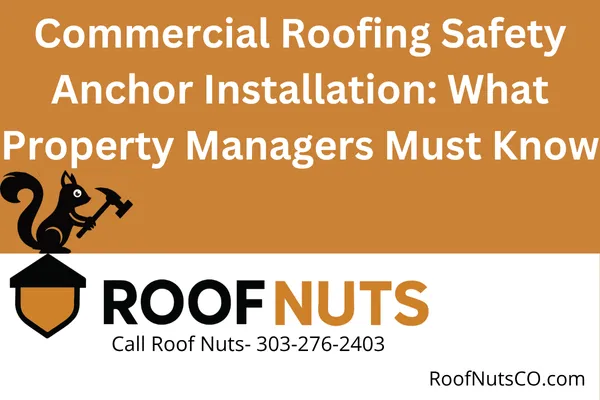
Commercial Roofing Safety Anchor Installation: What Property Managers Must Know
Commercial Roofing Safety Anchor Installation: Everything You Need to Know
Installing safety anchors on commercial roofs is not just a smart choice—it’s a legal and safety necessity. Whether you're managing a retail complex in Denver or a warehouse in Atlanta, permanent fall protection systems are critical for any maintenance, repair, or inspection work performed at height.
Here’s what you need to know.
What Are Safety Anchors?
Safety anchors are fixed devices attached to a building’s roof structure. They serve as secure points for workers to connect their personal fall arrest systems (PFAS), such as harnesses and lanyards.
These anchors:
Prevent serious falls
Comply with OSHA 1910.27 and 1926.502 regulations
Are often required for multi-story buildings and flat-roof commercial structures
Who Needs Them?
If you own or manage:
Office buildings
Schools or churches
Retail plazas
Industrial warehouses
Medical centers
…then your roof likely needs compliant fall protection systems. This is especially true in cities with large commercial footprints like Colorado Springs, Aurora, Atlanta, or Macon.
How Are Roof Anchors Installed?
Installing anchors is a technical process and must be done by a qualified contractor. Here's a step-by-step breakdown:
Inspection & Assessment
Evaluate the roof deck (metal, concrete, wood)
Identify load-bearing areas
Confirm code compliance for anchor locations
Engineering & Layout
Layout based on access points and roof use
Plan for future maintenance and window cleaning needs
Installation
Anchors are attached using through-bolts, welds, or surface-mounted plates
Proper flashing and sealing is critical to prevent leaks
All installations must meet local building code and OSHA fall arrest force limits
Testing & Certification
Each anchor is load-tested (typically to 5,000 lbs)
A system layout is recorded for future reference
Owners receive documentation and maintenance requirements
Common Anchor Types for Commercial Roofs
Single-point D-rings: For temporary tie-offs
Horizontal lifelines: Allow movement across longer spans
Parapet clamps or weighted anchors: For non-penetrating options on membrane roofs
Why It Matters in Colorado and Georgia
High winds, snow, and intense sun in Colorado mean regular roof inspections are a must—and that requires safe access. In Georgia, seasonal storms and vegetation buildup require constant maintenance, especially on flat-roof commercial properties.
Both regions also enforce strict building safety codes that require fall protection for commercial roof access.
FAQs
Do I need safety anchors even if no work is planned soon?
Yes. OSHA requires protection where workers may be exposed to a fall of 6 feet or more. Anchors must be installed before any maintenance work begins.
How long do anchors last?
With regular inspection and maintenance, anchors can last 10–20 years. Annual checks are typically required.
Can anchors be installed on an existing roof?
Yes. Anchors can be retrofitted to metal, membrane, or built-up roofs with proper engineering.
Final Thoughts
Investing in permanent safety anchors protects workers, reduces liability, and keeps your building compliant. Roof Nuts specializes in professional commercial anchor installations across Colorado and Georgia.
Whether you're in Fort Collins or Savannah, get a quote from our team and ensure your property is safe and up to code.
Colorado Office:
📍 Denver | 📞 303-276-2403
🌐 www.RoofNutsCO.com
